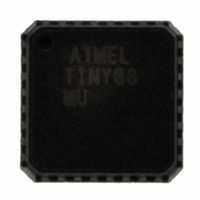ATTINY88-MU Atmel, ATTINY88-MU Datasheet - Page 36

ATTINY88-MU
Manufacturer Part Number
ATTINY88-MU
Description
MCU AVR 8K ISP FLASH 1.8V 32-QFN
Manufacturer
Atmel
Series
AVR® ATtinyr
Specifications of ATTINY88-MU
Core Processor
AVR
Core Size
8-Bit
Speed
12MHz
Connectivity
I²C, SPI
Peripherals
Brown-out Detect/Reset, POR, WDT
Number Of I /o
28
Program Memory Size
8KB (4K x 16)
Program Memory Type
FLASH
Eeprom Size
64 x 8
Ram Size
512 x 8
Voltage - Supply (vcc/vdd)
1.8 V ~ 5.5 V
Data Converters
A/D 8x10b
Oscillator Type
Internal
Operating Temperature
-40°C ~ 85°C
Package / Case
32-VQFN Exposed Pad, 32-HVQFN, 32-SQFN, 32-DHVQFN
Processor Series
ATTINY8x
Core
AVR8
Data Bus Width
8 bit
Data Ram Size
512 B
Interface Type
2-Wire, I2S, SPI
Maximum Clock Frequency
12 MHz
Number Of Programmable I/os
28
Number Of Timers
2
Maximum Operating Temperature
+ 85 C
Mounting Style
SMD/SMT
3rd Party Development Tools
EWAVR, EWAVR-BL
Development Tools By Supplier
ATAVRDRAGON, ATSTK500, ATSTK600, ATAVRISP2, ATAVRONEKIT, ATQT600, ATAVRTS2080B
Minimum Operating Temperature
- 40 C
On-chip Adc
10 bit, 8 Channel
Package
32QFN EP
Device Core
AVR
Family Name
ATtiny
Maximum Speed
12 MHz
Operating Supply Voltage
2.5|3.3|5 V
Cpu Family
ATtiny
Device Core Size
8b
Frequency (max)
12MHz
Total Internal Ram Size
512Byte
# I/os (max)
28
Number Of Timers - General Purpose
2
Operating Supply Voltage (typ)
2.5/3.3/5V
Operating Supply Voltage (max)
5.5V
Operating Supply Voltage (min)
1.8V
Instruction Set Architecture
RISC
Operating Temp Range
-40C to 85C
Operating Temperature Classification
Industrial
Mounting
Surface Mount
Pin Count
32
Package Type
QFN EP
For Use With
ATSTK600-DIP40 - STK600 SOCKET/ADAPTER 40-PDIPATAVRDRAGON - KIT DRAGON 32KB FLASH MEM AVR
Lead Free Status / RoHS Status
Lead free / RoHS Compliant
Available stocks
Company
Part Number
Manufacturer
Quantity
Price
Company:
Part Number:
ATTINY88-MU
Manufacturer:
ATMEL
Quantity:
21 342
Part Number:
ATTINY88-MU
Manufacturer:
ATMEL/爱特梅尔
Quantity:
20 000
Part Number:
ATTINY88-MUR
Manufacturer:
AT
Quantity:
20 000
7. Power Management and Sleep Modes
7.1
7.1.1
36
Sleep Modes
ATtiny48/88
Idle Mode
Sleep modes enable the application to shut down unused modules in the MCU, thereby saving
power. The AVR provides various sleep modes allowing the user to tailor the power consump-
tion to the application’s requirements.
When enabled, the Brown-out Detector (BOD) actively monitors the power supply voltage during
the sleep periods. To further save power, it is possible to disable the BOD in some sleep modes.
See
Figure 6-1 on page 28
tion. The figure is helpful in selecting an appropriate sleep mode.
sleep modes, their wake up sources and the BOD disable ability.
Table 7-1.
Notes:
To enter any of the sleep modes, the SE bit in SMCR must be written to logic one and a SLEEP
instruction must be executed. The SM1, and SM0 bits in the SMCR Register select which sleep
mode (Idle, ADC Noise Reduction, or Power-down) will be activated by the SLEEP instruction.
See
If an enabled interrupt occurs while the MCU is in a sleep mode, the MCU wakes up. The MCU
is then halted for four cycles in addition to the start-up time, executes the interrupt routine, and
resumes execution from the instruction following SLEEP. The contents of the Register File and
SRAM are unaltered when the device wakes up from sleep. If a reset occurs during sleep mode,
the MCU wakes up and executes from the Reset Vector.
Note that if a level triggered interrupt is used for wake-up the changed level must be held for
some time to wake up the MCU (and for the MCU to enter the interrupt service routine). See
“External Interrupts” on page 53
When the SM[1:0] bits are written to 00, the SLEEP instruction makes the MCU enter Idle mode,
stopping the CPU but allowing the SPI, Analog Comparator, ADC, 2-wire Serial Interface,
Timer/Counters, Watchdog, and the interrupt system to continue operating. This sleep mode
basically halts clk
Sleep Mode
Idle
ADC Noise Reduction
Power-down
“Software BOD Disable” on page 37
Table 7-2 on page 39
1. For INT1 and INT0, only level interrupt
Active Clock Domains and Wake-up Sources in the Different Sleep Modes
CPU
and clk
presents the different clock systems in the ATtiny48/88, and their distribu-
Active Clock Domain
for a summary.
FLASH
for details.
, while allowing the other clocks to run.
X
for more details.
X
X
Oscillator
X
X
X
X
X
(1)
(1)
Table 7-1
X
X
X
Wake-up Source
X
X
shows the different
X
X
8008G–AVR–04/11
X
X
X
X















